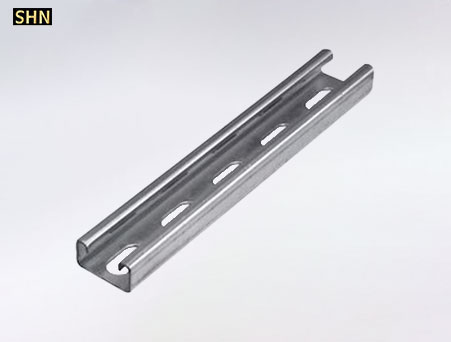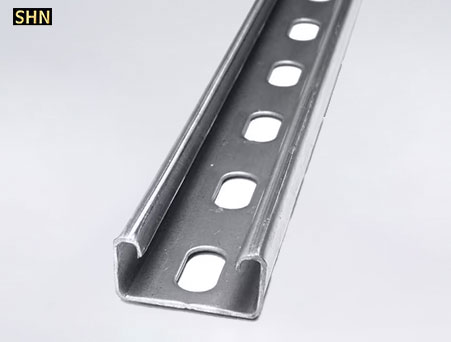+86 10 5248 4022
+86 18518927929

Mar. 12, 2024
Unistrut channel, often referred to simply as "strut," is a versatile structural system used in various industries for supporting pipes, conduits, cables, and other equipment. It consists of a continuous slotted channel made from galvanized steel, stainless steel, or aluminum. Unistrut channels come in different profiles, including shallow, deep, and half-slot configurations, providing flexibility for different applications.

Understanding the weight-bearing capacity of Unistrut channels is crucial for ensuring the safety and stability of installations. Whether used in industrial facilities, commercial buildings, or residential projects, knowing the load capacity helps engineers, architects, and contractors make informed decisions regarding design, material selection, and installation methods.
The weight-bearing capacity of Unistrut channels is determined through rigorous testing and calculations based on engineering principles. Manufacturers conduct load tests to determine the maximum load a channel can support under different conditions, such as static and dynamic loads. Factors such as material strength, channel profile, and support spacing are considered in these calculations.
Several factors influence the load capacity of Unistrut channels, including material type, channel profile, support spacing, and installation method. Galvanized steel channels typically have higher load capacities compared to aluminum channels due to their superior strength. The depth and width of the channel also play a significant role, with deeper and wider channels generally offering higher load capacities.
While Unistrut channels come with predetermined load capacities based on their specifications, certain modifications can be made to increase load-bearing capabilities. Reinforcing the channels with additional supports, using thicker gauge materials, or opting for specialized channel profiles designed for heavy-duty applications are some strategies to enhance load capacity. However, any modifications should be carefully evaluated to ensure structural integrity and compliance with safety standards.
Unistrut channels are designed and manufactured in accordance with industry standards and specifications to ensure consistency and reliability in load-bearing performance. Organizations such as ASTM International and the Metal Framing Manufacturers Association (MFMA) establish standards for materials, dimensions, and load ratings of Unistrut channels. Compliance with these standards is essential to guaranteeing the safety and quality of installations.
Interpreting load capacity specifications requires an understanding of various factors, including channel material, profile, and support spacing. Load capacity charts provided by manufacturers offer guidance on the maximum allowable loads for different configurations. Engineers and designers must consider both static and dynamic loads, as well as factors such as wind, seismic activity, and temperature variations, when interpreting load capacity specifications for specific applications.
Yes, Unistrut offers a range of channel profiles and accessories designed to accommodate varying load requirements. Standard channels come in shallow, deep, and half-slot configurations, with load capacities specified for each profile. Additionally, specialty channels with higher load ratings, such as Superstrut and Defender channels, are available for heavy-duty applications. Choosing the appropriate type of Unistrut channel depends on factors such as load magnitude, environmental conditions, and installation constraints.

Manufacturers conduct rigorous testing to determine the load capacity of Unistrut channels before they are released to the market. These tests involve subjecting the channels to various loads, both static and dynamic, to simulate real-world conditions. Testing procedures adhere to industry standards and may include methods such as static load testing, dynamic load testing, and fatigue testing. The results of these tests are used to establish load capacity ratings for different channel configurations.
When purchasing Unistrut channels, customers should look for certifications and approvals from recognized testing agencies and regulatory bodies. Common certifications include those from ASTM International, Underwriters Laboratories (UL), and the International Code Council (ICC). These certifications indicate that the channels meet specific performance criteria and comply with relevant industry standards and building codes. Additionally, third-party testing and certification provide an added layer of assurance regarding the quality and reliability of Unistrut channels.
Industry best practices for load testing of Unistrut channels include following standardized procedures, using calibrated equipment, and documenting test results accurately. Load tests should be conducted by qualified personnel in controlled environments to ensure consistency and repeatability. It is essential to adhere to recommended safety protocols during testing to prevent accidents or damage to equipment. Additionally, periodic retesting may be necessary to verify the continued integrity of Unistrut channels over time.
The quality of installation plays a critical role in determining the load capacity of Unistrut channels in real-world applications. Proper alignment, secure anchoring, and appropriate fastening techniques are essential for ensuring structural stability and load-bearing performance. Improper installation practices, such as over-tightening bolts, uneven spacing of supports, or inadequate bracing, can compromise the integrity of the installation and reduce load capacity.
Yes, environmental conditions such as temperature fluctuations, exposure to moisture, and corrosive atmospheres can affect the load-bearing performance of Unistrut channels. For example, exposure to extreme temperatures can cause thermal expansion or contraction, potentially affecting the structural integrity of the channels. Similarly, corrosive environments can accelerate material degradation, leading to premature failure. Engineers and designers should account for these factors when specifying Unistrut channels for outdoor or harsh environment applications.
Regular maintenance is essential for sustaining the load capacity and longevity of Unistrut channel installations. Inspections should be conducted periodically to identify any signs of wear, damage, or corrosion that may affect structural integrity. Cleaning and lubricating moving parts, replacing worn components, and addressing any deficiencies promptly can help prevent costly repairs or accidents. Additionally, preventive maintenance measures, such as applying protective coatings or installing corrosion-resistant hardware, can prolong the service life of Unistrut channels in demanding environments.
In heavy-duty industrial settings, Unistrut channels play a crucial role in supporting heavy equipment, machinery, and structural components. For example, in manufacturing facilities, Unistrut channels are used to mount conveyor systems, support overhead cranes, and secure piping and ductwork. Load capacity requirements in these applications are typically high, necessitating the use of robust channel profiles and proper reinforcement techniques to ensure structural stability and safety.
In commercial construction projects, Unistrut channels are commonly employed for various structural and mechanical applications. For instance, in office buildings, Unistrut channels are used to support HVAC systems, electrical conduits, and lighting fixtures. Load capacity considerations in these projects depend on factors such as building height, occupancy type, and seismic design requirements. Engineers must carefully assess load-bearing requirements and select appropriate channel configurations to meet structural demands and regulatory standards.
Unistrut channels also find applications in residential and do-it-yourself (DIY) projects, where they offer versatility and ease of installation. For instance, homeowners may use Unistrut channels to create custom shelving units, mount televisions, or support garage storage systems. While load capacity requirements in residential settings may be lower compared to industrial or commercial applications, it is still essential to choose the right channel profiles and installation methods to ensure safety and durability.
During the installation of Unistrut channels, several safety precautions should be observed to prevent accidents and ensure compliance with safety standards. These precautions include wearing appropriate personal protective equipment (PPE), securing ladders and scaffolding properly, and using fall protection equipment when working at heights. Additionally, following manufacturer recommendations for installation procedures and load capacity limits is crucial for maintaining structural integrity and minimizing the risk of injuries or property damage.
To safeguard against overloading and structural failures, engineers and designers should carefully assess load requirements and select Unistrut channels with adequate load capacities for the intended applications. It is essential to avoid exceeding the maximum allowable loads specified by manufacturers and to consider factors such as dynamic loads, impact forces, and environmental conditions. Implementing redundancy measures, such as using multiple channels or adding supplementary supports, can also help distribute loads evenly and reduce the risk of overloading.
There are several warning signs that may indicate impending load capacity issues with Unistrut channel installations. These include visible signs of sagging, bending, or deformation in the channels, unusual noises or vibrations during operation, and visible corrosion or rusting of metal components. If any of these warning signs are observed, immediate action should be taken to assess the integrity of the installation and address any underlying issues to prevent potential failures or accidents.
The weight-bearing capacity of a standard Unistrut channel depends on various factors, including the material type, channel profile, support spacing, and installation method. Typically, load capacity charts provided by manufacturers offer guidance on the maximum allowable loads for different configurations. For example, a 1-5/8-inch wide by 1-5/8-inch deep Unistrut channel made from galvanized steel may have different load capacities compared to an aluminum channel of the same dimensions.
Yes, Unistrut channels are designed to support both static and dynamic loads in various applications. Dynamic loads, such as those caused by moving equipment, vibrations, or wind forces, are considered during the design and testing of Unistrut channel systems. Engineers and designers should account for dynamic load factors when specifying Unistrut channels to ensure structural integrity and safety under dynamic loading conditions.
Yes, Unistrut channel installations are subject to maximum span limitations based on factors such as channel profile, material type, and load requirements. Span tables provided by manufacturers offer guidance on the maximum allowable distances between supports for different channel configurations. Exceeding the maximum span can result in excessive deflection, compromising the stability and load-bearing capacity of the installation.
Stainless steel Unistrut channels typically have higher load capacities compared to galvanized steel channels due to the superior strength and corrosion resistance of stainless steel. However, the difference in load capacity between stainless steel and galvanized channels may vary depending on factors such as channel profile, material grade, and environmental conditions. Engineers should consult manufacturer specifications and load capacity charts to select the most suitable channel material for specific applications.
Welded and bolted connections can affect the load capacity of Unistrut channel installations differently. Welded connections provide a rigid and continuous joint, distributing loads more evenly along the length of the channel. Bolted connections, on the other hand, offer flexibility and ease of assembly but may require additional reinforcement to achieve comparable load capacities. Engineers should consider factors such as joint design, material compatibility, and structural requirements when selecting connection methods for Unistrut channel installations.
Yes, Unistrut channels can be used for seismic applications, provided they are designed and installed according to seismic design criteria and building codes. Seismic bracing systems utilizing Unistrut channels are commonly employed to secure mechanical, electrical, and plumbing (MEP) components in buildings located in seismic zones. Proper bracing configurations, anchorage methods, and reinforcement techniques are essential for ensuring the seismic resilience of Unistrut channel installations.
Calculating the load capacity for a specific application involves considering factors such as the weight of the supported equipment, the distance between supports, environmental conditions, and any additional loads or forces acting on the installation. Engineers typically use load capacity charts provided by manufacturers, along with applicable engineering principles and building codes, to determine the appropriate Unistrut channel configuration and support spacing for the desired load capacity.
Load capacity charts, technical specifications, and other resources for Unistrut channels are available from manufacturers' websites, product catalogs, and engineering manuals. Additionally, consulting with experienced engineers, architects, or Unistrut distributors can provide valuable insights and assistance in selecting the right channel profiles and accessories for specific applications.
Leave Message
Write down your urgent needs to get free samples, and to check our stocks

Copyright © SS&HN INDUSTRY GROUP Ltd. All Rights Reserved | Sitemap | Powered by 